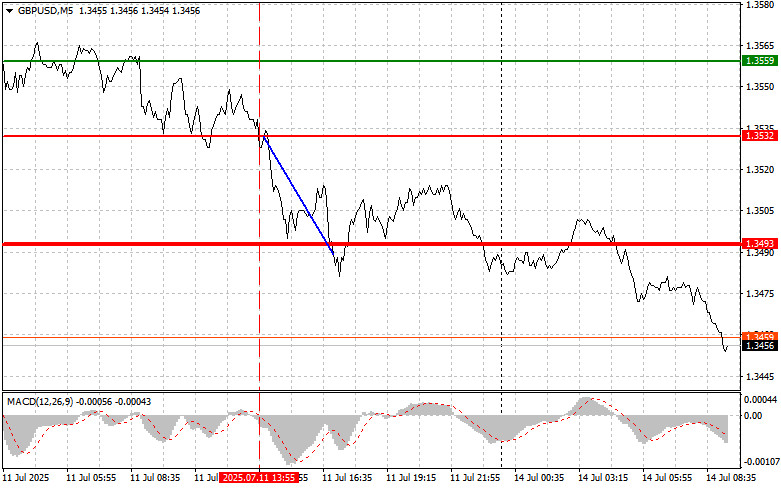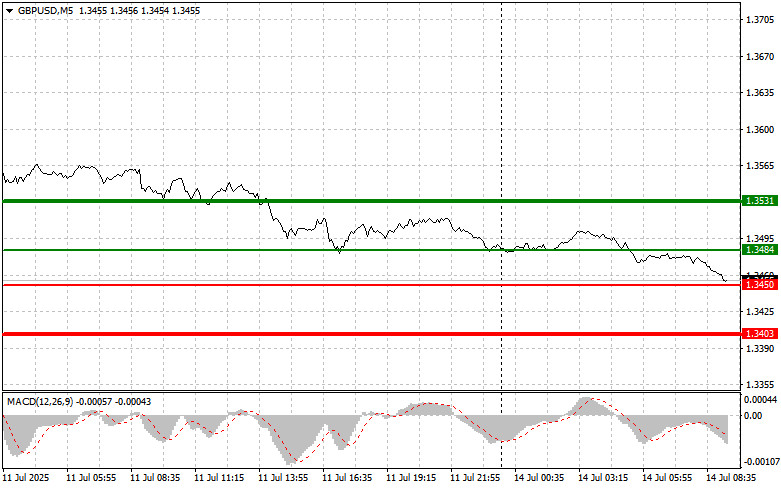Analysis of Trades and Trading Tips for the British Pound
The price test at 1.3532 occurred when the MACD indicator had just begun moving downward from the zero line, confirming a valid entry point for selling the pound and resulting in a drop of over 30 pips for the pair.
Disappointing GDP and industrial production figures for the UK triggered a collapse in the pound sterling at the end of last week. Investors, concerned by signs of slowing economic growth, continued actively selling the British currency, which led to a sharp depreciation against both the US dollar and the euro. The reported data was significantly worse than expected, reinforcing concerns about the future of the British economy amid ongoing uncertainty related to U.S. trade policy. The decline in industrial production is particularly alarming, as it signals a reduction in the country's export capabilities and a drop in the international competitiveness of British companies.
Unfortunately, there are no UK data scheduled for today, meaning the bearish pressure on the pound may persist as a new downtrend unfolds. This creates a perfect storm for the British currency. The absence of positive economic news leaves the pound without support, making it vulnerable to further speculative attacks. The bearish market already forming around the pound could intensify in the absence of any counterarguments.
For intraday strategy, I will focus primarily on Scenarios #1 and #2.
Buy Scenario
Scenario #1: I plan to buy the pound today if the entry point around 1.3484 is reached (green line on the chart), with a target of rising toward 1.3531 (thicker green line on the chart). Around the 1.3531 level, I plan to exit long positions and open shorts in the opposite direction (expecting a 30–35 pip pullback from the level). Any upward movement in the pound today is likely to be corrective.
Important! Before buying, make sure that the MACD indicator is above the zero line and just beginning to rise from it.
Scenario #2: I also plan to buy the pound today in the event of two consecutive tests of the 1.3450 level, at a time when the MACD indicator is in oversold territory. This will limit the pair's downside potential and lead to a market reversal to the upside. A rise toward the opposite levels of 1.3484 and 1.3531 can be expected.
Sell Scenario
Scenario #1: I plan to sell the pound today after a break below the 1.3450 level (red line on the chart), which may lead to a quick decline in the pair. The key target for sellers will be 1.3403, where I plan to exit short positions and immediately buy in the opposite direction (expecting a 20–25 pip rebound from the level). Selling the pound on any rally remains valid in line with the ongoing bearish trend.
Important! Before selling, make sure that the MACD indicator is below the zero line and just beginning to decline from it.
Scenario #2: I also plan to sell the pound today in the event of two consecutive tests of the 1.3484 level, at a time when the MACD indicator is in overbought territory. This will limit the pair's upside potential and lead to a market reversal downward. A decline toward the opposite levels of 1.3450 and 1.3403 can be expected.
What's on the Chart:
- The thin green line represents the entry price where the trading instrument can be bought.
- The thick green line indicates the expected price level where a Take Profit order can be placed, or profits can be manually secured, as further price growth above this level is unlikely.
- The thin red line represents the entry price where the trading instrument can be sold.
- The thick red line indicates the expected price level where a Take Profit order can be placed, or profits can be manually secured, as further price decline below this level is unlikely.
- The MACD indicator should be used to assess overbought and oversold zones when entering the market.
Important Notes:
- Beginner Forex traders should exercise extreme caution when making market entry decisions. It is advisable to stay out of the market before the release of important fundamental reports to avoid exposure to sharp price fluctuations. If you choose to trade during news releases, always use stop-loss orders to minimize potential losses. Trading without stop-loss orders can quickly wipe out your entire deposit, especially if you neglect money management principles and trade with high volumes.
- Remember, successful trading requires a well-defined trading plan, similar to the one outlined above. Making impulsive trading decisions based on the current market situation is a losing strategy for intraday traders.














